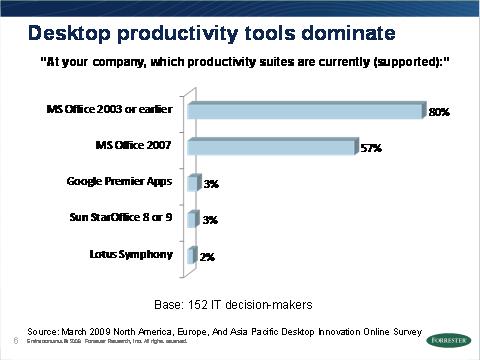Microsoft Office still owns the desktop, future of StarOffice unclear

Since the Oracle acquisition of Sun, there’s been no official word yet onthe road map for Star Office. Oracle says it’s vision is to deliver an integrated system from applications to disk, ostensibly a commitment to an OpenOffice.org productivity suite. Yet, that’s not a foregone conclusion. Star Office was just part of the package Oracle got in its acquisition of Sun. Its relative value is to give Oracle a starting point to compete with Microsoft Office, but more likely Star Office’s journey with Oracle will take one of two paths:
- An independent productivity toolsfoundation. Upon the acquisition announcement, Open Office.org leaders begged for the emancipation of Star Office, saying a spin-offwould be more in spirit with the open source community. The view is that Oracle makes billions of dollars licensing proprietary software and its control of Star Office is out of sync with OpenOffice.org’s mission. Oracle’s retention of Sun’s OpenOffice.org assets puts at risk the use of the OpenOffice.org name and the ability to reissue the code under a different license. There is a real possibility that Oracle will jettison Star Office and let OpenOffice.org invest in its further development, a la Mozilla’s efforts with Firefox.
- Integration with Oracle CRM and enterprise apps. Oracle has the opportunity to address some of the glaring deficiencies of Star Office –- like macro support and mail merge –- that keep it from competing with Microsoft Office. It also could integrate its Star Office with its CRM and database applications. Oracle CEO Larry Ellison would love to take on Microsoft, and his company has tried to develop alternatives to Office in the past (Oracle Office division from the early 1990s). But the likelihood that Oracle can turn Star Office 9 into the Microsoft Office killer that Sun couldn’t is hard to fathom. More likely, its useful capabilities would be culled and integrated with Oracle apps rather thana stand-alone alternative toMicrosoft Office.
A third outcome might be that Oracle abandons Star Office, or lets it die a slow death. The OpenOffice productivity suites market feels crowded now that IBM’sLotus Symphony released version 1.2 to join Star Office 9 and OO3. To date, none of the alternatives to Microsoft Office –- OpenOffice or SaaS –- have made any significant inroads against Microsoft’s desktop dominance, currently supported by more than 80% of enterprises(see figure).Combined, the alternatives make up about 8% of the market and Star Office is only about 3%. It will be an uphill battle to displace Microsoft Office with such a fragmented group of Open Office alternatives, and itmay prove a battle not worth fighting for Oracle given Sun’s host of other assets.
